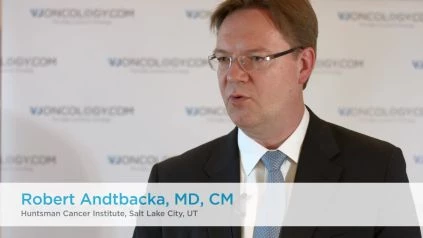Robert Andtbacka, MD, CM of the Huntsman Cancer Institute, Salt Lake City, UT talks about the update on the randomized Phase III OPTiM study for melanoma in which patients with unresectable stage IIIb, IIIc and stage IV melanoma received intralesional talimogene laherparepvec (T-VEC) versus GM-CSF subcutaneously (NCT00769704), presented at the 2016 World Congress on Cancers of the Skin (WCCS) and the Congress of the European Association of Dermato-Oncology (EADO) in Vienna, Austria. The response pattern of earlier stage patients, patients with stage IIIb, stage IIIc and stage IV m1A disease were looked at. Prof. Andtbacka explains that it was found that the responce in the group treated with T-VEC was over 40% and many of these patients had complete responses (CR). Furthermore, it was found that 25% of patients treated with T-VEC had a durable response, a response that lasted 6 months or longer. They were then interested in determining how those responses occured. With immunotherapies, often patients can have progression of the disease before they respond or develop new lesions before they respond. These specific response patterns were looked at. It was found that of the patients that were treated with T-VEC that had a durable response, half had progression prior to responding and the majority of these had new lesions that developed. The study also showed that in the group of patients that had no progression prior to responding, the median time to response was 3.1 months whereas patients that had progression prior to responding, the median time was 5.1 months. However, whether or not there was progression prior to responding, did not affect overall survival (OS) and duration of the response. Prof. Andtbacka concludes by explaining that he believes when patients are treated with T-VEC, even if they progress during the initiation, they should continue to be treated with T-VEC as long as the progression is not clinically significant.
[the_ad id="32629"]

